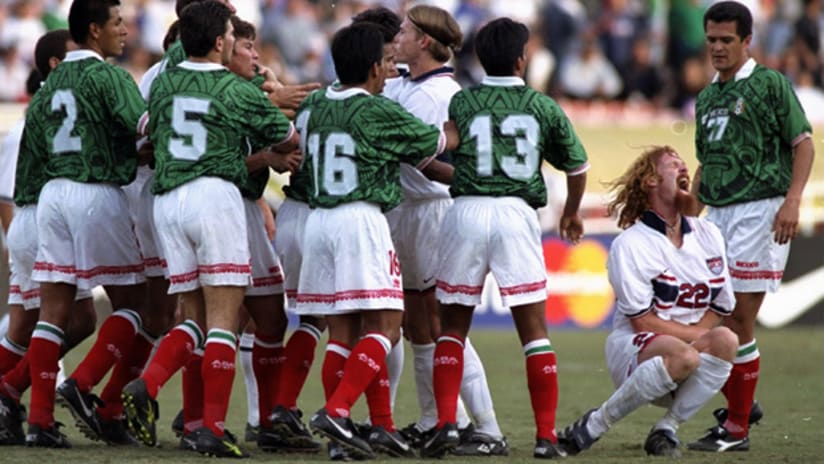The soccer world as we’ve known it for the last 20 years changed this week. And when it did, there were no alarm bells. No barking dogs, no crying children, no notice of any kind save for a months-old dispatch from CONCACAF and a 200-word afterthought of a story in La Prensa – a Honduran paper, no less.
In an unmarked grave next to the Hexagonal – the six-team, final round of CONCACAF World Cup qualifying – rests the US-Mexico rivalry. Sure, it will go on. But it will never be the same.
US vs. Mexico is one of the pillars upon which the success of soccer in the States and, by extension, soccer in the region, has been built. When the US rose to soccer prominence with the Harkes/Dooley/Ramos era, they finally gave Mexico a legitimate foil in the region. Mexico, in turn, gave the US a bully, a nemesis, an alter ego that each new generation had to best to earn their stripes.
[inlinenode:317553]Both sides had heroes and villains. Alexi Lalas and Cobi Jones epitomized everything the Mexicans seemed to hate about the US. Luis Hernández and Cuauhtémoc Blanco played the opposite role and became the focus of US ire.
On this side of the Rio Grande, Mexico were the cheaters. The team that tried to get away with fielding overage players in the 1988 Olympics and were banned from the 1990 World Cup as a result. The team that dove after every stiff breeze, complained after every call and had excuses after every humiliation.
South of the border, the Yanks were burros – talentless clods who were better without the ball than with it, a team whose success was as offensive as it was inexplicable.
Friendlies between the two sides were intense, and undeserving of such a harmless moniker. Gold Cup meetings could be brutal. And the US Cup, now consigned to the trash bin of history, provided US fans with many of their best memories.
[inlinenode:317554]But the real antipathy, the real measure of men, came in World Cup qualifiers. Whether it was Eric Wynalda coughing up black phlegm after a scoreless draw at the Azteca in 1997 – a game in which the Mexican crowd cheered the Americans off the pitch and whistled their own team – or Michael Bradley’s brace last year in the middle of a frozen Columbus winter, qualifiers were where leaders were born and dominance established.
It’s unimaginable that something so important has been killed off. But in the world of sports, the unimaginable happens on a recurring basis. Major League Baseball cancelled the World Series. The NHL punted an entire season. The NBA’s getting ready to do the same next year.
When the unimaginable becomes the inevitable, it’s because of money. There’s no way to sugarcoat it or soften it. Money makes the world go ‘round, and soccer is the world’s game. You can do the math from there.
So here’s the way qualifying will work now. There are three rounds, each consisting of groups of four teams. The top two teams from each group will advance until there are two final groups of four. Presumably, the US will be in one group while Mexico will be in the other.
This means more games and more money for the Bermudas and Grenadas of the world, teams that in the past would be eliminated in a simple home-and-home in the first round.
In many ways, the new format is a good thing. The breakdown of votes makes it clear that a date against the US team is now, officially, a draw. Talk to anyone who’s been around US soccer for more than 15 years and they’ll shake their head in wonder at that reality.
[inline_node:317555]And let’s be fair: No one should be against more money flowing to the impoverished nations of the region, nations where kids use tightly wound socks or plastic bags as makeshift soccer balls. These countries need the money for infrastructure and training, and the chance to produce the next generation of Shalrie Josephs or Sean Goaters.
Nor should anyone fret over the finances of the Mexican and US Federations. The USSF will replace a qualifier against Mexico that draws 23,000 people in Columbus with a friendly against Mexico that draws 90,000 people in Dallas. The Fed will do just fine.
The FMF, for their part, won’t feel compelled to schedule a game in the middle of a workday this cycle (that’s right – the US’ 2-1 loss at the Azteca in last year’s qualifier happened at 1 p.m. local time on a Wednesday). Instead, they can persuade the US to play a friendly in Phoenix, or LA, or San Diego, and charge a premium that Mexican expats have proven, time and again, they are willing to pay.
Financially, nobody really loses here.
Emotionally, however, the fans do. And emotion is what has fueled the beautiful game’s rise on this continent.
So this is the next test for US soccer. Can the game as we’ve built it in this country survive without its arch-enemy? It’s a wonder if interest will continue to grow if there’s no one to point to and say, “They’re the bad guys, they’re the ones who could keep us from the World Cup.”
Will the soccer world as we know it end up better or worse off when all is said and done?
No one can claim to know for certain one way or the other. All that can be said is, somewhere down the line, folks will look back at this week and say, “That’s when things changed.”


